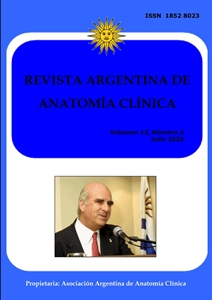Medidas y análisis cadavérico del triángulo interescalénico y espacios costo-claviculares en relación con el sindrome de salida torácica
DOI:
https://doi.org/10.31051/1852.8023.v12.n2.28585Palabras clave:
Interscalene triangle, costoclavicular space, thoracic outlet syndromeResumen
Objetivos: El síndrome de salida torácica (TOS) es un trastorno de las extremidades superiores resultante de la compresión de estructuras del plexo braquial y vasos subclavios dentro de la región de salida torácica en cualquiera de los tres sitios primarios: triángulo interescalénico, espacio costoclavicular y espacio menor retro-pectoral. Este estudio se centró en la exploración anatómica detallada y la medición de la variabilidad anatómica normal dentro del triángulo interescalénico y el espacio costoclavicular. Material y método: Examinamos 49 cadáveres (222 hombres y 27 mujeres) y disecaron ambos lados para explorar y examinar 98 áreas. Medimos el ancho de la base, la altura, el ángulo dentro del triángulo interescalénico y la distancia vertical dentro del espacio costoclavicular. También calculamos el área del triángulo interescalénico. Resultados: Los valores medios de anchura de la base, altura, angulación del triángulo interescalénico y altura del espacio costoclavular fueron de 10,18 x 4,31 mm, 45,19 a 0,07 mm, 10,85 a 0,06 grados y 10,22 a 0,07 mm, respectivamente. El área media del triángulo interescalénico fue de 214,82 x 5,22 mm. Conclusión: Hemos encontrado diferencias clínicamente significativas entre las alturas verticales del espacio interescalénico y costiclavicular; la altura del espacio costoclavicular fue significativamente menor en lo clínico que el espacio interescalénico (p< 0,001). No se encontró ninguna diferencia clínicamente significativa entre las mediciones masculinas y femeninas. Estos rangos de conjunto de datos podrían ser útiles para planificar enfoques de tratamiento en TOS.
Referencias
Atasoy E. 1996. Thoracic outlet compression syndrome. Orthopedic Clinica of North Am. 27 :265-303.
Archie M, Rigberg D. 2017. Vascular TOS—Creating a Protocol and Sticking to It. Diagnostics. 10:7.
Cagli K,Ozcakar L, Beyazit M, Sirmali M. 2006. Thoracic outlet syndrome in an adolescent with bilateral bifid ribs. Clinical Anatomy. 19(6):558–60.
Davidovic LB, Kostic DM, Jakovljevic NS, Kuzmanovic IL, Simic TM. 2003. Vascular thoracic outlet syndrome. World Journal of Surgery. 27 (5):545–50.
Degeorges R, Reynaud C, Becquemin JP. 2004. Thoracic outlet syndrome surgery: longterm functional results. Annals of Vascular Surgery. 18(5):558–65.
Demondion X, Boutry N, Drizenko A, Paul C, Francke J, Cotton A. 2000. Thoracic outlet: anatomic correlation with MR imaging. Am J Roenterol., 175:417-22.
Demondion X, Bacqueville E, Paul C, Duquesnoy B, Hachulla E, Cotton A. 2003.Thoracic outlet: assessment with MR imaging in asymptomatic and symptomatic populations. Radiology. 227 (2):461–8.
Demondion X, Herbinet P, Van S, Boutry N, Chantelot C, Cotton A. 2006. Imaging assessment of thoracic outlet syndrome. Radiographics. 26:1735–50.
Dahlstrom KA, Olinger AB.2012. Descriptive anatomy of the interscalene triangle and the costoclavicular space and their relationship to thoracic outlet syndrome: a study of 60 cadavers. J Manipulative Physiol Ther. 35 (5):396-401.
Gockel M, Vastamaki M, Alaranta H.1994. Long-term results of primary scalenotomy in the treatment of thoracic outlet syndrome. Journal of Hand Surgery [Br]. 19(2):229–33.
Gliedt JA, Clinton JD, Enix ED. 2013. Clinical Brief: Neurogenic Thoracic Outlet Syndrome
Topics in Integrative Health Care. 4(3).
Hooper TL, Denton J, McGalliard MK, Brismée JM, Sizer PS Jr.2010. Thoracic outlet syndrome: a controversial clinical condition. Part 1: anatomy and clinical examination/diagnosis. J Man Manip Ther. 18(2):74–83.
Jordan A, Gliedt DC, Clinton J, Daniels DC, Dennis E, Enix DC. 2013. Clinical Brief: Neurogenic Thoracic Outlet Syndrome. Topics in Integrative Health Care. 4(3).
Kaplan T, Comert A, Esmer AF, Atac GK, Acar HI, Ozkurt B. 2018.The importance of costoclavicular space on possible compression of the subclavian artery in the thoracic outlet region: a radio-anatomical study. Interact CardioVasc Thorac Surg. 27:561–5.
Levine N, Rigby BR. 2018.Thoracic Outlet Syndrome: Biomechanical and Exercise Considerations Healthcare (Basel). 6(2): 68.
Mackinnon SE, Novak CB.2002.Thoracic Outlet Syndrome. Curr. Probl. Surg. 39: 1070–1145.
Roos DB. 1976. Congenital anomalies associated with thoracic outlet syndrome. Anatomy, symptoms, diagnosis and treatment. Am J Surg. 132:771-8.
Remy JM, Remy J, Masson P, Bonnel F, Debatselier P, Vinckier L.2000. Helical CT angiography of thoracic outlet syndrome. Am J Roent. 174:1667-74.
Sheth RN, Belzberg AJ.2001. Diagnosis and treatment of thoracic outlet syndrome. Neurosurg Clin N Am. 12(2):295-309.
Savgaonkar MG. Chimmalgi M, Kulkarni UK. 2006. Anatomy of inter-scalene triangle and its role in thoracic outlet syndrome. J Anat Soc India. 55:52-5.
Sanders RJ, Hammond SL, Rao NM. 2007. Diagnosis of Thoracic Outlet Syndrome. J. Vasc. Surg., 46:601–604.
Urschel JD, Hameed SM, Grewal RP. 1994. Neurogenic Thoracic Outlet Syndromes. Postgrad. Med. J. 70:785–789.
Urschel CH. 2005. Transaxillary First Rib Resection for Thoracic Outlet Syndrome. Operative Techniques in Thoracic and Cardiovascular Surgery. 10(4):313-317.
Van Es HW. 2001. MRI of the brachial plexus. European Radiology.11(2):325–36.
Watson LA, Pizzari T, Balster S. 2009.Thoracic outlet syndrome part 1 Clinical manifestations, differentiation and treatment pathways Manual Therapy.14:586–595.
Descargas
Publicado
Número
Sección
Licencia
Derechos de autor 2020 Subhramoy Chaudhury, Anasuya Ghosh

Esta obra está bajo una licencia internacional Creative Commons Atribución-NoComercial 4.0.
Los autores/as conservarán sus derechos de autor y garantizarán a la revista el derecho de primera publicación de su obra, el cuál estará simultáneamente sujeto a la Licencia de reconocimiento de Creative Commons que permite a terceros compartir la obra siempre que se indique su autor y su primera publicación en esta revista. Su utilización estará restringida a fines no comerciales.
Una vez aceptado el manuscrito para publicación, los autores deberán firmar la cesión de los derechos de impresión a la Asociación Argentina de Anatomía Clínica, a fin de poder editar, publicar y dar la mayor difusión al texto de la contribución.



